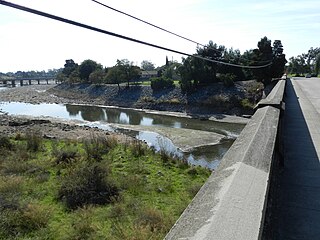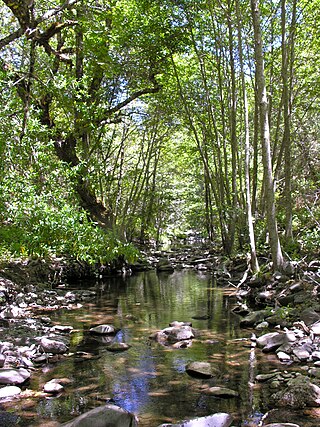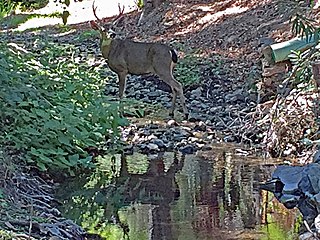Related Research Articles

The Guadalupe River mainstem is an urban, northward flowing 14 miles (23 km) river in California whose much longer headwater creeks originate in the Santa Cruz Mountains. The river mainstem now begins on the Santa Clara Valley floor when Los Alamitos Creek exits Lake Almaden and joins Guadalupe Creek just downstream of Coleman Road in San Jose, California. From here it flows north through San Jose, where it receives Los Gatos Creek, a major tributary. The Guadalupe River serves as the eastern boundary of the City of Santa Clara and the western boundary of Alviso, and after coursing through San José, it empties into south San Francisco Bay at the Alviso Slough.

Alum Rock Park, in the Alum Rock district of San Jose, California, is California's oldest municipal park, established in 1872 but serving as public land since the pueblo was established in 1777. Located in a valley in the Diablo Range foothills on the east side of San Jose, the 720 acre (2.9 km2) park offers 13 miles (21 km) of trails, varying from fairly level along Penitencia Creek to sharp switchbacks climbing to the ridges to the South Rim Trail and the North Rim Trail. The narrow floor of the valley includes a visitor center, a small museum/animal rehab facility, picnic areas, playgrounds, lawns, sand volleyball pits, mineral springs, lush plant life, woodlands, creek play opportunities, and occasional group camping.

Arroyo Hondo is a northwestward-flowing 13.0-mile-long (20.9 km) river in Santa Clara County, California, United States, that lies east of Milpitas. The area is privately owned by the San Francisco Water Department and is closed to public access because of its usage as drinking water. Bounded to the east by Oak Ridge and to the west by Poverty Ridge, Arroyo Hondo empties into the Calaveras Reservoir where it joins Calaveras Creek. It is formed by the confluence of Smith Creek and Isabel Creek which drain the west and east slopes of Mount Hamilton, respectively.

Coyote Creek is a river that flows through the Santa Clara Valley in Northern California. Its source is on Mount Sizer, in the mountains east of Morgan Hill. It eventually flows into Anderson Lake in Morgan Hill and then northwards through Coyote Valley to San Jose, where it empties into San Francisco Bay.

Stevens Creek is a 20.9-mile-long (33.6 km) stream in Santa Clara County, California. The creek originates in the Santa Cruz Mountains on the western flank of Black Mountain in the Monte Bello Open Space Preserve near the terminus of Page Mill Road at Skyline Boulevard. It flows southeasterly through the Stevens Creek County Park before turning northeast into Stevens Creek Reservoir. It then continues north for 12.5 miles (20.1 km) through Cupertino, Los Altos, Sunnyvale and Mountain View before emptying into the San Francisco Bay at the Whisman Slough, near Google's main campus.

Alameda Creek is a large perennial stream in the San Francisco Bay Area. The creek runs for 45 miles (72 km) from a lake northeast of Packard Ridge to the eastern shore of San Francisco Bay by way of Niles Canyon and a flood control channel. Along its course, Alameda Creek provides wildlife habitat, water supply, a conduit for flood waters, opportunities for recreation, and a host of aesthetic and environmental values. The creek and three major reservoirs in the watershed are used as water supply by the San Francisco Public Utilities Commission, Alameda County Water District and Zone 7 Water Agency. Within the watershed can be found some of the highest peaks and tallest waterfall in the East Bay, over a dozen regional parks, and notable natural landmarks such as the cascades at Little Yosemite and the wildflower-strewn grasslands and oak savannahs of the Sunol Regional Wilderness. After an absence of half a century, ocean-run steelhead trout are able to return to Alameda Creek to mingle with remnant rainbow trout populations. Completion of a series of dam removal and fish passage projects, along with improved stream flows for cold-water fish and planned habitat restoration, enable steelhead trout and Chinook salmon to access up to 20 miles (32 km) of spawning and rearing habitat in Alameda Creek and its tributaries. The first juvenile trout migrating downstream from the upper watershed through lower Alameda Creek toward San Francisco Bay was detected and documented in April 2023.

The Los Gatos Creek runs 24 miles (39 km) in California through Santa Clara Valley Water District's Guadalupe Watershed from the Santa Cruz Mountains northward through the Santa Clara Valley until its confluence with the Guadalupe River in downtown San Jose. The Guadalupe River then continues onward into San Francisco Bay.

San Francisquito Creek is a creek that flows into southwest San Francisco Bay in California, United States. Historically it was called the Arroyo de San Francisco by Juan Bautista de Anza in 1776. San Francisquito Creek courses through the towns of Portola Valley and Woodside, as well as the cities of Menlo Park, Palo Alto, and East Palo Alto. The creek and its Los Trancos Creek tributary define the boundary between San Mateo and Santa Clara counties.

Smith Creek is a 14-mile-long (23 km) perennial stream which flows along the western flank of Mount Hamilton in Santa Clara County. The creek begins near Bollinger Ridge, about 7.7 km SxSW of Mount Hamilton.

Pinole Creek is a stream in western Contra Costa County, in the East Bay region of the San Francisco Bay Area, California.

Adobe Creek, historically San Antonio Creek, is a 14.2-mile-long (22.9 km) northward-flowing stream originating on Black Mountain in the Santa Cruz Mountains. It courses through the cities of Los Altos Hills, Los Altos, and Palo Alto on its way to the Palo Alto Flood Basin and thence to southwestern San Francisco Bay in Santa Clara County, California, United States. Historically, Adobe Creek was a perennial stream and hosted runs of steelhead trout entering from the Bay, but these salmonids are now blocked by numerous flood control structures, including a tidal gate at the creek's mouth and a long concretized rectangular channel culminating in an impassable drop structure at El Camino Real. The co-founders of Adobe Systems both lived on Adobe Creek.

Permanente Creek is a 13.3-mile-long (21.4 km) stream originating on Black Mountain in Santa Clara County, California, United States. Named by early Spanish explorers as Arroyo Permanente or Río Permanente because of its perennial flow, the creek descends the east flank of Black Mountain then courses north through Los Altos and Mountain View, discharging into southwest San Francisco Bay historically at the Mountain View Slough but now virtually entirely diverted via the Permanente Creek Diversion Channel to Stevens Creek and Whisman Slough in San Francisco Bay.

Hale Creek is a short stream originating in the foothills of Los Altos Hills, California in Santa Clara County, California, United States. Its source is in the Rancho San Antonio Open Space Preserve, west of Neary Quarry. The creek flows northeasterly 4.6 miles (7.4 km) through the cities of Los Altos Hills, Los Altos, and Mountain View before joining Permanente Creek.

Saratoga Creek is a north-northeast flowing creek in Santa Clara County, California.

San Tomas Aquinas Creek, known locally as San Tomas Aquino Creek, is a 16.5-mile-long (26.6 km) stream that heads on El Sereno mountain in El Sereno Open Space Preserve in Saratoga, California in Santa Clara County, California, United States. It flows north through the cities of Saratoga, Monte Sereno, Los Gatos, Campbell, Santa Clara and San Jose before its confluence with the Guadalupe Slough in south San Francisco Bay.

Pacheco Creek is a 28 miles (45 km) west by southwest flowing stream which heads in the Diablo Range in southeastern Santa Clara County and flows to San Felipe Lake, the beginning of the Pajaro River mainstem, in San Benito County, California.

Alamitos Creek or Los Alamitos Creek is a 7.7-mile-long (12.4 km) creek in San Jose, California, which becomes the Guadalupe River when it exits Lake Almaden and joins Guadalupe Creek. Los Alamitos Creek is located in Almaden Valley and originates from the Los Capitancillos Ridge in the Santa Cruz Mountains, near New Almaden. This creek flows through the Valley's Guadalupe Watershed, which is owned by the Santa Clara Valley Water District. The creek flows in a generally northwesterly direction after rounding the Los Capitancillos Ridge and the town of New Almaden, in the southwest corner, before ambling along the Santa Teresa Hills on northeast side of the Almaden Valley. Its environment has some relatively undisturbed areas and considerable lengths of suburban residential character. Originally called Arroyo de los Alamitos, the creek's name is derived from "little poplar", "alamo" being the Spanish word for "poplar" or "cottonwood".
San Felipe Creek is a 14 miles (23 km) stream that originates in the western Diablo Range in Santa Clara County, California. It flows south by southeast through two historic ranchos, Rancho Los Huecos and Rancho Cañada de San Felipe y Las Animas before it joins Las Animas Creek just above Anderson Reservoir. One of the nine major tributaries of Coyote Creek, the creek's waters pass through the Santa Clara Valley and San Jose on the way to San Francisco Bay.

Arroyo Valle or Arroyo Del Valle is a 36.4-mile-long (58.6 km) westward-flowing stream that begins in northeastern Santa Clara County, California, and flows northwesterly into Alameda County where it is dammed to form Lake Del Valle. After that Arroyo Valle is tributary to Arroyo de la Laguna which in turn flows into Alameda Creek and thence to San Francisco Bay. In the past, the Arroyo Valle had a significant steelhead migration; however, degradation of the stream in the latter half of the 20th century has decimated this anadromous fish population.

Isabel Creek is a 18-mile-long (29 km) perennial stream which flows northwesterly along the eastern then northern flank of Mount Hamilton in Santa Clara County. It joins Smith Creek to form Arroyo Hondo north of Mt. Hamilton and is part of the southernmost Alameda Creek watershed.
References
- 1 2 Erwin G. Gudde; William Bright (1949). California Place Names: The Origin and Etymology of Current Geographical Names. Berkeley, California: University of California Press. p. C-242. Retrieved 2011-05-14.
- 1 2 Hubert H. Bancroft (1886). History of California. 1884-90. San Francisco, California: A.L. Bancroft and Company. p. 184 . Retrieved 2011-05-14.
encarnacion arroyo.
- 1 2 Upper Penitencia Creek (PDF) (Report). Santa Clara Valley Water District. Archived from the original (PDF) on 2012-03-19. Retrieved 2011-05-14.
- 1 2 3 U.S. Geological Survey Geographic Names Information System: Penitencia Creek
- 1 2 Beller, Erin; Grossinger, Robin; Nicholson, Maika; Salomon, Micha (June 2012). Upper Penitencia Creek Historical Ecology Assessment (PDF) (Report). Richmond, California: San Francisco Estuary Institute. Retrieved 2012-08-11.
- 1 2 Richey, A.; Dusterhoff, S. D.; McKnight, K.; Salomon, M.; Hagerty, S.; Askevold, R. A.; Grossinger, R. M. (December 2018). Resilient Landscape Vision for Upper Penitencia Creek. SFEI Contribution No. 894 (Report). Richmond, California: San Francisco Estuary Institute - Aquatic Science Center. Retrieved March 16, 2019.
- ↑ U.S. Geological Survey Geographic Names Information System: Lower Penitencia Creek
- ↑ "Lower Penitencia Creek Watershed Map". Oakland Museum. Retrieved 2011-05-14.
- ↑ Reference: Lingusittic Field Notes Northern Costanoan (1925-1934) of John Peabody Harrington
- ↑ Santa Clara Basin Watershed Management Initiative (SCBWMI) Watershed Assessment Subgroup (August 2003). Watershed Characteristics Report - Chapter 7: Natural Setting (PDF) (Report). Santa Clara Valley Urban Runoff Pollution Prevention Program. p. 179. Archived from the original (PDF) on 2011-07-18. Retrieved 2012-08-11.
- ↑ "Cherry Flat Reservoir". Geographic Names Information System . United States Geological Survey, United States Department of the Interior.
- 1 2 J. J. Smith (1998). Steelhead and other Fish Resources of Western Mt. Hamilton Streams (PDF) (Report). San Jose State University. Archived from the original (PDF) on 2008-09-08. Retrieved 2012-08-09.
- ↑ Leidy, Robert A.; Becker, Gordon; Harvey, Brett N. (2005). "Historical Status of Coho Salmon in Streams of the Urbanized San Francisco Estuary, California" (PDF). California Fish and Game: 243. Retrieved 2011-05-14.
- ↑ Buchan, L. A. J.; Leidy, R. A.; Hayden, M. K. (1999). Aquatic resource characterization of Western Mt. Hamilton Stream fisheries (Report). Sunnyvale, California: The Nature Conservancy.
- ↑ Stillwater Sciences (2006-08-18). Upper Penitencia Creek Limiting Factors Analysis Final Technical Report (PDF) (Report). Santa Clara Valley Urban Runoff Prevention Program. p. 172. Retrieved 2012-08-11.
- 1 2 Gordon S. Becker; Isabelle J. Reining; David A. Asbury; Andrew Gunther (August 2007). San Francisco Estuary Watersheds Evaluation: Identifying Promising Locations for Steelhead Restoration in Tributaries of the San Francisco Estuary (PDF) (Report). p. 14. Retrieved 2011-05-14.
- ↑ "Estuary Passage Improvement Program". Center for Ecosystem Management and Restoration (CEMAR). Retrieved 2011-05-14.
- ↑ Edmonds-Mares, Julie; Horwedel, Joseph (2011-11-21). Cooperative Agreement with Santa Clara Valley Transportation Authority for Riparian Improvements in Upper Penitencia Creek in Alum Rock Park (PDF) (Report). Archived from the original (PDF) on 2017-01-26. Retrieved 2012-08-11.
- ↑ "Penitencia Creek Trail" . Retrieved 2012-08-11.
- ↑ "Berryessa Transit Center & Berryessa/North San Jose BART Station". Santa Clara Valley Transportation Authority . Retrieved 2019-10-07.
- ↑ "Parks Gateway: Berryessa BART Project". Bay Area Ridge Trail . 2018-02-01. Retrieved 2019-10-07.
- ↑ "2012-2013 Freshwater Sport Fishing Regulations". California Dept. of Fish and Game. Archived from the original on 2012-06-25. Retrieved 2012-08-11.